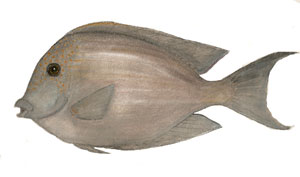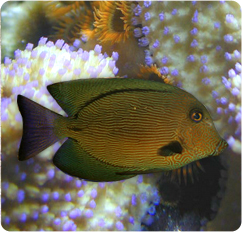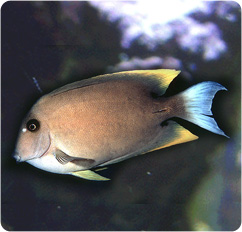|
Genus Ctenochaetus Bristletooth Tangs
Tantalizing Tangs with Strange Teeth
 |
A Striped Bristletooth Tang (Ctenochaetus striatus)
by Karen Talbot |
Fishes from the Family Acanthuridae are commonly known as surgeonfishes and tangs, and they are perennial favorites for marine aquarists. One genus in this family is the genus Ctenochaetus (pronounced ten-oh-key-tus), otherwise known as the bristletooth tangs. In this genus, you will find aquarium favorites like the blue eye tang (Ctenochaetus binotatus), the chevron tang (C. hawaiiensis), the flame fin tang (C. tominiensis), the spotted yellow eye tang (C. truncates), the striped bristletooth tang (C. striatus), and the yellow eye Kole tang (C. strigosus). These are beautiful fish that are as behaviorally interesting as they are beautifully colored.
What sets the tangs from the genus Ctenochaetus apart is their mouths and dentition. Looking again at the genus’ common name—bristletooth tangs—provides a clue (actually Ctenochaetus roughly translates as “comb bristle”) as to what sets these fishes apart. Look at a Ctenochaetus tang’s mouth, and you will see that it is turned out and protrudes from its face. Look inside its mouth and, rather than seeing fixed teeth, you will in fact find flexible, “comb-like” teeth. Why do they have this unusual dentition? If you watch a Ctenochaetus tang feed, you will understand that it is because of this adaptation that they can so easily lift and scrape soft algae (and all the good stuff in algae, which is why they are truly omnivores and not strictly herbivores as some people assume) from hard surfaces and substrate.
Ctenochaetus tangs are yet another good example of fishes whose behavior observed in the wild should not be the only guide in husbandry practices adopted by the aquarist. While seen in shoals in the wild, Ctenochaetus tangs should, as a general rule, not be kept with other members of the genus (although they may be kept with individuals from other genera of tangs). In terms of their compatability with other fishes, they are mostly peaceful fishes that are reef-compatible in so far as they usually leave sessile invertebrates (like coral) alone. If underfed, however, it is often noted that Ctenochaetus tangs will pick at large polyp stony corals.
 |
| Adult Chevron Tang (Ctenochaetus hawaiiensis) |
Compared with some other tangs with which the aquarist may be familiar, Ctenochaetus tangs may appear less gregarious—even bordering on shy. A Ctenochaetus tang will therefore only truly adapt to an aquarium with loads of live rock providing lots of places to hide and forage for food. Most individuals from this genus appreciate high flow environments and plenty of algae growth, so if you plan to keep these fishes, make sure you are comfortable with keeping an aquarium that is not “sparkling clean.” Overskimming or in any other way over-filtering an aquarium with Ctenochaetus tangs can lead to problems down the road.
Undoubtedly the biggest and most pressing issue with newly aquired Ctenochaetus tangs is feeding. Too many individuals unnecessarily starve to death in the home aquarium, and while this is often secondary to improper collection, holding or shipping, it is almost entirely avoidable. Due to these fishes' unusual mouth shape, they commonly suffer from a condition sometimes called “bag rub.” If your Ctenochaetus tang arrives with a swollen mouth, and you do not pay particular attention to feeding the animal, it will most likely starve to death in your aquarium. Luckily, this is easily avoided by offering the “right” food to new arrivals.
 |
A Flame Tang (Ctenochaetus tominiensis)
|
In the wild, Ctenochaetus tangs spend their day swimming around on the reef in search of marine algae and any meaty bits of food they can find. It is therefore recommended to feed new arrivals fresh algae. Purchasing (and then culturing your own) live macroalgae like ogo algae (Gracilaria parvisipora) is an excellent idea if you plan to keep any tang, but especially tangs from the genus Ctenochaetus and especially new arrivals. Even tangs with mouth trauma will be able to consume this food, and they should recover fairly quickly. In addition, dried marine algae (Nori), spirulina flakes and frozen mysis shrimp will usually be taken with zeal. Most Ctenochaetus tangs will quite easily adjust to captive diets and will eventually eat just about any flake or pellet foods. It is recommended, however, to soak flake foods in some type of vitamin supplement (like Selcon) or a garlic supplement in order to help the fish fight off any possible parasite infestation and offer balanced nutrition.
In conclusion, Ctenochaetus tangs are fantastic aquarium fishes if provided with the proper husbandry. They are boldly colored, display fascinating behavior and adapt well given the proper aquarium environment.
Published 18 August 2008. © Blue Zoo Aquatics
|